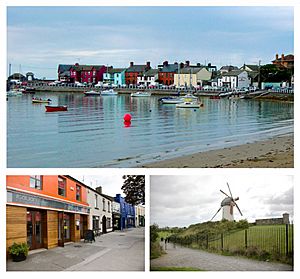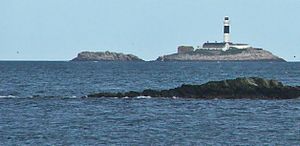Skerries, Dublin facts for kids
Skerries (meaning "rocky islands" in Irish) is a lovely coastal town in Fingal, north County Dublin, Ireland. It used to be a busy fishing port and a place where people did a lot of hand embroidery. These jobs became less common in the early 1900s. After that, Skerries became a popular holiday spot and a town where people live and travel to Dublin for work. Dublin is about 30 miles (48 km) south of Skerries. There are several islands off the coast, and one of them, Rockabill, is a special place for nature.
Quick facts for kids
Skerries
Na Sceirí
|
|
|---|---|
|
Town
|
|

Clockwise from top: Brightly painted houses lining Skerries harbour; the Great Windmill; businesses on Strand Street
|
|
| Country | Ireland |
| Province | Leinster |
| County | County Dublin |
| Local government area | Fingal |
| Elevation | 5 m (16 ft) |
| Population
(2022)
|
|
| • Urban | 10,743 |
| Time zone | UTC±0 (WET) |
| • Summer (DST) | UTC+1 (IST) |
| Eircode routing key |
K34
|
| Telephone area code | +353(0)1 |
| Irish Grid Reference | O248606 |
Contents
- What's in a Name?
- Exploring Skerries' Geography
- Skerries Through Time
- Learning in Skerries
- Getting Around Skerries
- Martello Towers: Coastal Defenders
- Arts and Music in Skerries
- Skerries' Achievements
- Sports and Activities
- Places of Worship
- Local Legends
- Famous People from Skerries
- Images for kids
- See also
What's in a Name?
The name Skerries comes from an old Norse word, sker. This word means a small, rocky island or reef that might be covered by water when the tide is high. In the Irish language, this word became sceir, and when there are many of them, it's called na sceirí.
Exploring Skerries' Geography
Skerries is built on land that gently slopes towards the sea. There are some low cliffs along the coast. The town has hills around it, like Mill Hill, where a windmill has stood for a long time. The main part of the town is built around three long streets: Strand Street, Church Street, and Balbriggan Road.
Skerries South Strand is a long, sandy beach, about 2.5 kilometers (1.5 miles) long. Places like Red Island, Mill Hill, and Ardgillan Park offer great views of the town.
Islands Near Skerries
There are five islands off the coast of Skerries:
- Shenick Island
- St Patrick's Island
- Colt Island
- Rockabill (which is actually two islands, "The Cow" and "The Calf")
- Red Island (which is a "tied island," meaning it's connected to the mainland by a narrow strip of land at low tide)
Rockabill Island is very important because it has the largest group of roseate terns (a type of seabird) breeding in Europe. It also has a lighthouse, which is about 4 miles (6.4 km) from the closest path on the mainland.
Shenick Island has a Martello tower, which is a strong defensive building. These towers were built by the British during the Napoleonic Wars to protect the coast. You can sometimes walk to Shenick Island at very low tides, but it's important to be careful because the tides can change quickly. The other islands are harder to reach and usually require a boat. St Patrick's Island is named because it's believed that Saint Patrick landed there a long, long time ago.
Skerries Through Time
Early Days and Visitors
Long ago, in the second century C.E. (Common Era), old stories say that an island off Skerries was used by invaders to land. This was probably Shenick or Red Island, which would have been a tidal island back then. The invaders marched to the mainland at low tide but were quickly defeated.

Around the year 432 C.E., Saint Patrick is said to have landed on Church Island. Soon after, a monastery was founded there by Saint Mochonna.
In 797 C.E., the Vikings came to Ireland and raided the monastery on Church Island. Because many local names in Skerries come from Norse words, it's thought that the Vikings settled here. Later, in 1120, a man named Sitric, whose father was a Dane, rebuilt the monastery on Church Island. He dedicated it to Saint Patrick. By this time, many of the Vikings who had settled in Ireland had become Christians.
In 1148, Saint Malachy, a very important church leader, held a meeting on St Patrick's Island. This meeting was to help solve disagreements between Irish Christians and the Pope. Many bishops, priests, and other church members attended.
The Middle Ages in Skerries
In 1320, the area of Skerries was given to a knight named Sir Michael le Veel. His family later changed their name to Calf.
In 1496, the head of the Holmpatrick monastery was allowed by King Henry VII to build a pier in Skerries. At this time, Skerries belonged to the Holmpatrick monastery and was known as the Port of Holmpatrick.
Changes During the Reformation
After the Protestant Reformation, a big change in religion, the monastery and its lands in Skerries became the property of Thomas Fitzpatrick in 1565.
In 1583, when the Catholic Church was not allowed in Ireland, Archbishop Dermot O'Hurley secretly came ashore at Holmpatrick Strand in Skerries. He was met by a priest and traveled onward. Archbishop O'Hurley later became one of the 24 Irish Catholic Martyrs.
In 1605, the lands of Holmpatrick were given to Donogh O'Brien, 4th Earl of Thomond. The last Earl, Henry O'Brien, 8th Earl of Thomond, sold the land, including Skerries town, to the Hamilton family in 1721. Maps from the 1700s suggest that the Hamilton family helped design the streets of Skerries as they are today.
Between 1863 and 1865, a monument was built in Skerries to remember James Hans Hamilton, who was a local landlord and a Member of Parliament. Later, in 1897, Hamilton's son was given the title of Lord Holmpatrick.
Skerries in the 1900s
After the Easter Rising in 1916, British soldiers landed in Skerries to help stop the rebellion in Dublin. During the Irish Civil War in 1922, a well-known leader, Harry Boland, was seriously injured and later died at the Skerries Grand Hotel.
Holiday Fun at Red Island
In the late 1940s, a family holiday camp was built on Red Island by the Quinn family, who later started the Superquinn supermarkets. This camp had many bedrooms all under one roof, along with places to eat and for entertainment. The holiday camp closed in the early 1970s. The ballroom was still used for concerts for a while, but all the buildings were taken down in the 1980s. Today, much of Red Island is a public park for everyone to enjoy.
Skerries Mills and Modern Growth
Starting in the late 1900s, the Skerries Mills were restored. They now have two working windmills, a watermill, a museum, and a coffee shop. It's a popular place for both locals and tourists. In 2007, storms damaged the sails on one of the windmills, but they were later fixed.
Like many areas near Dublin, Skerries saw a lot of new homes being built and house prices increasing in the late 1990s and early 2000s.
Learning in Skerries
Skerries has one secondary school called Skerries Community College. It was formed in 1982 when three different schools joined together. It's a school for both boys and girls. There are also five primary schools in the town: Réalt na Mara National School, St. Patrick's National School, Holmpatrick National School, Milverton National School, and Educate Together Skerries National School.
Getting Around Skerries
The town has its own train station, Skerries railway station. Most trains go to Connolly and Pearse stations in Dublin, or to Drogheda and Dundalk. Bus routes 33 and 33A also pass through Skerries. The M1 motorway is the closest main road for cars.
Martello Towers: Coastal Defenders
The two Martello towers in Skerries, one on Red Island and one on Shenick Island, are part of a group of 29 towers built in the early 1800s. The British built them along the Irish and English coasts. Their purpose was to protect against a possible invasion by Napoleon's French armies and to act as an early warning system. The tower on Red Island was once part of the Red Island Holiday Camp. Since the camp was taken down in the 1980s, the tower has stood by itself.
Arts and Music in Skerries
Skerries has been home to various musicians. These include Tony Keeling and the Graduates from the showband era, and the extreme metal band Primordial, which started in Skerries in the 1980s. Singer-songwriter Ryan O'Shaughnessy, who represented Ireland in the Eurovision Song Contest 2018, is also from Skerries.
Skerries' Achievements
Skerries has won many awards for its beautiful scenery, culture, and community spirit. For example, in 2014, Skerries came second in the "Best Place to Live in Ireland" awards. In 2011, the town was the only place to win an award as an entire community at RTÉ & Rehab's People of the Year Awards. In 2016, Skerries was named Ireland's Tidiest Town in a national competition. Skerries was also listed as one of Europe's ten most beautiful cities by the Eating Europe Food Tours blog.
Sports and Activities
Skerries has many local sports clubs. These include Skerries Harps GAA (for Gaelic games), Skerries Town Football Club (for soccer), and Skerries RFC (for rugby).
The Skerries Sailing Club is located by the harbour and has many different types of boats. The "Measle" dinghy, a small sailboat, was even designed in Skerries in 1960.
BirdWatch Ireland, the local branch, organizes talks and outdoor events for people interested in birds. The town also hosts the yearly Skerries 100 and Killalane motorcycle races.
Places of Worship
Skerries is a parish in the Roman Catholic Archdiocese of Dublin. The town also has a Church of Ireland church, Holmpatrick St Patrick, and a Skerries Methodist Church.
Local Legends
A fun local story says that when Saint Patrick lived on St Patrick's Island near Skerries, his only friend was a goat. One day, when he went to the mainland, his goat was supposedly stolen and eaten. The legend says that Saint Patrick then made the people of Skerries unable to speak properly, making them shriek and bleat like goats. Their voices only returned when they admitted what they had done. Because of this story, the goat is sometimes used as a symbol for Skerries.
Famous People from Skerries
- Steven Beattie, a soccer player
- Bobby Beggs, a Gaelic footballer
- Bryan Cullen, a Gaelic footballer
- Lyndsey Davey, a Gaelic footballer
- Grian Chatten, lead singer of the band Fontaines D.C.
- Ciarán Frawley, a rugby player
- Jim Glennon, a former rugby player and politician
- Thomas Hand, an Irish revolutionary who died during the Irish War of Independence. Hand Street is named after him.
- Killian Keane, a rugby player
- Caitlín Rebekah Kiernan, an author and paleontologist
- D. P. Moran, an Irish nationalist writer
- Alan O'Connor, a rugby player
Images for kids
See also
 In Spanish: Skerries (Dublín) para niños
In Spanish: Skerries (Dublín) para niños







